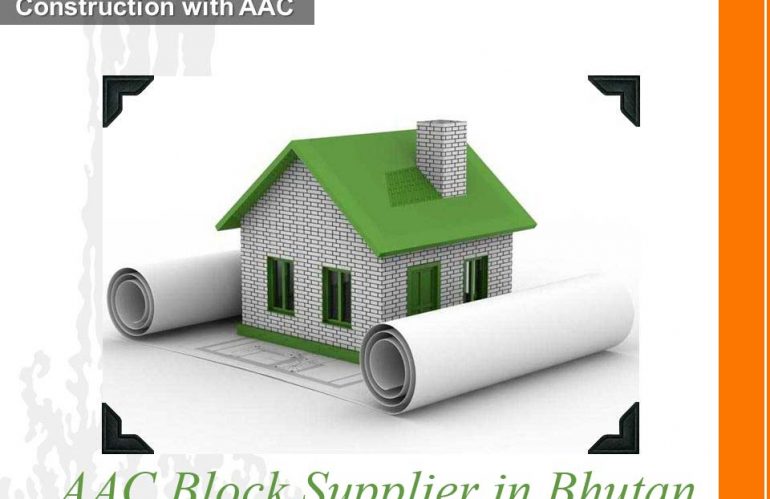Construction Material Supply in Bhutan
AAC BLOCKS (landed price in Thimphu)
We are dealer & supplier of Building Construction Products in Bhutan and our product range are AAC Block, uPVC. We also provide advice on sourcing construction material at a competitive rates.
Rate in Thimphu – Nu. 6,300 per cubic meter
RED BRICKS (landed price in Thimphu)
- Pal & Co (First class) – Nu. 18 per piece
- First class – Nu. 16.73 piece
- Second class – Nu. 15.36 per piece
Benefit & Features of AAC
Dimension & Weight of AAC blocks
| Dimension of AAC (mm) | Cubic meter of 1 AAC block | No of AAC block in 1 cum | Weight of 1 AAC block (kg) | 1 Block equivalent to no of red bricks | Coverage area per cum (in sqft) |
| 600*200*075 | 0.009 | 111 | 7-Jun | 5 | 154.96 |
| 600*200*100 | 0.012 | 83 | 9-Aug | 7 | 116.33 |
| 600*200*125 | 0.015 | 66 | 11-Oct | 8 | 93.07 |
| 600*200*150 | 0.018 | 55 | 13-Dec | 9.5 | 77.56 |
| 600*200*175 | 0.021 | 47 | 14/15 | 11 | 66.35 |
| 600*200*200 | 0.024 | 41 | 16/17 | 13 | 58.17 |
| 600*200*225 | 0.027 | 37 | 18/19 | 14 | 51.65 |
| 600*200*250 | 0.03 | 33 | 20/21 | 16 | 46.08 |
| Note: | |||||
| The above data is correct to an approximate value. | |||||
| The above coverage area is considering 12mm thickness of joining mortar. | |||||
About Autoclaved Aerated Concrete Blocks
AAC is a lightweight cellular material which is formed by a chemical reaction between finely divided calcareous and siliceous materials. The calcareous component is usually lime and/or cement. The siliceous component usually consists of natural or ground sand and/or industrial by-products such as slag and pulverized fuel ash (PFA), also known by fly ash. The cellular structure is achieved by either a chemical process causing aeration, or by introducing air voids by mechanical means into a slurry which contains no coarse material The aeration is caused by the addition of a small quantity of acidic aluminium paste that reacts with the alkaline lime &; cement to expand the mixture.
This reaction causes the release of hydrogen gas and the formation of tiny, finely dispersed bubbles. The hydrogen dissipates after the reaction process leaving the air filled bubbles. After mixing, the slurry is placed in a mould for curing. For products that require reinforcing, the corrosion protected steel reinforcing mesh is placed in the mould before the slurry is added. After a few hours curing the product is firm enough to be removed from the moulds and transported to a cutting machine where it is cut precisely into the required sizes. Waste material is recycled back for crushing and remixing.
Autoclaving is the final stage of curing the material under steam pressure. This takes up to 12 hours, with a pressure gradient reaching around 1.25MPa at and 190oC. Steam is cycled through successive autoclaves, reducing energy loads. The blocks, panels and lintels are removed from the autoclave and packed ready for transporting. The AAC produced has a dry density of approximately 550kg/m3, giving it a dry density approximately one-quarter the density of normal reinforced concrete.
Autoclaved Aerated Concrete (AAC), also known as Autoclaved Cellular Concrete (ACC),Autoclaved Lightweight Concrete (ALC) is a lightweight, precast, foam concrete building material invented in the mid-1920s that simultaneously provides structure, insulation, and fire – and mold- resistance and various other advantages. It is also an environment friendly product, as it is manufactured using 65-70% of sand/ fly ash (by weight). Due to its many desirable attributes, AAC Blocks has gained massive popularity in Northern, Western and Southern India with almost 80 percent of the constructions using AAC Blocks as a replacement of the traditional fried clay bricks. In the North Eastern region, it is gaining popularity since 2012 and is looking to completely replace the use of traditional fried clay bricks.
AAC was perfected in the mid-1920s by the Swedish architect and inventor Dr.Johan Axel Eriksson, working with Professor Henrik Kreuger at the Royal Institute of Technology. The process was patented in 1924. In 1929, production started in Sweden at the city of Yxhult. From “Yxhult Anghardade Gasbetong” later became the first registered building materials brand in the world: Ytong. The second major international cellular concrete Hebel brand goes back to company founder and technicians Josef Hebel from Memmingen. In 1943, the first Hebel-plant was opened in Germany.
Originally Ytong autoclaved aerated concrete in Sweden was produced with alum shale, whose combustible carbon content made it beneficial to use in the production process. Unfortunately, the slate deposits used for Ytong in Sweden also contains a very low level of natural content uranium, which makes the material give off radioactive radon gas to the building. By using new recipes, containing only Quartz sand/ Fly ash , Calcined gypsum, Lime(mineral),Cement, Water and Aluminum powder, after 1975, Ytong produced a new type of aerated concrete blocks which doesn’t contain alum slate anymore and thus the problem of radon exposure from this raw material eliminated since this time. The production of this white autoclaved aerated concrete is state of the art since those days and similar recipes are used by all producers all over the world.
